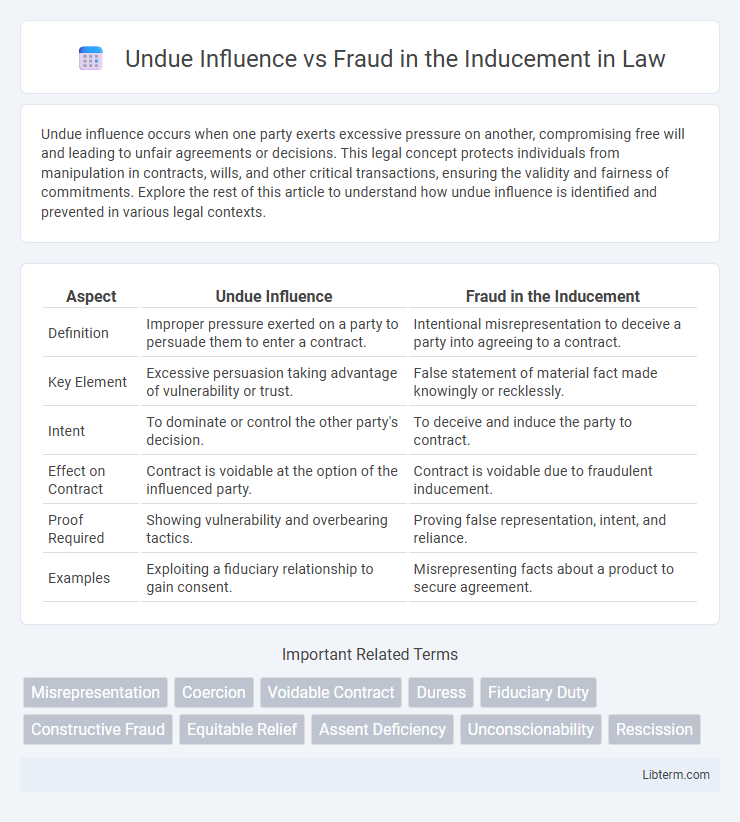Undue influence occurs when one party exerts excessive pressure on another, compromising free will and leading to unfair agreements or decisions. This legal concept protects individuals from manipulation in contracts, wills, and other critical transactions, ensuring the validity and fairness of commitments. Explore the rest of this article to understand how undue influence is identified and prevented in various legal contexts.
Table of Comparison
| Aspect | Undue Influence | Fraud in the Inducement |
|---|---|---|
| Definition | Improper pressure exerted on a party to persuade them to enter a contract. | Intentional misrepresentation to deceive a party into agreeing to a contract. |
| Key Element | Excessive persuasion taking advantage of vulnerability or trust. | False statement of material fact made knowingly or recklessly. |
| Intent | To dominate or control the other party's decision. | To deceive and induce the party to contract. |
| Effect on Contract | Contract is voidable at the option of the influenced party. | Contract is voidable due to fraudulent inducement. |
| Proof Required | Showing vulnerability and overbearing tactics. | Proving false representation, intent, and reliance. |
| Examples | Exploiting a fiduciary relationship to gain consent. | Misrepresenting facts about a product to secure agreement. |
Understanding Undue Influence: Definition and Key Elements
Undue influence occurs when one party exerts excessive pressure on another, overriding their free will, often exploiting a position of trust or authority. Key elements include vulnerability of the victim, dominance of the influencer, improper or excessive persuasion, and resulting impairment of the victim's ability to make independent decisions. Distinguishing undue influence from fraud involves recognizing that undue influence primarily manipulates consent through coercion or authority rather than false statements or deception.
Defining Fraud in the Inducement: Core Concepts
Fraud in the inducement occurs when one party intentionally misrepresents or conceals material facts to deceive another party into entering a contract. This misrepresentation must be proven to have directly influenced the victim's decision, leading them to consent under false pretenses. Unlike undue influence, which involves manipulation or coercion, fraud in the inducement specifically centers on deliberate deception affecting contractual consent.
Legal Differences: Undue Influence vs Fraud in the Inducement
Undue influence involves coercion or manipulation to overpower a party's free will, resulting in a transaction that benefits the influencer, while fraud in the inducement entails intentional misrepresentation or deceit to persuade a party to enter into a contract. Legally, undue influence requires proof of a confidential or fiduciary relationship and demonstrates that the influenced party lacked free consent, whereas fraud requires evidence of false statements, knowledge of their falsity, intent to deceive, and reliance by the victim. Courts differentiate these claims by assessing the nature of the coercion versus deceit involved in vitiating the contract's validity.
Common Scenarios of Undue Influence
Common scenarios of undue influence typically involve situations where one party exerts excessive pressure or manipulates another to gain an unfair advantage, such as in elder financial abuse or confidential relationships like attorney-client or guardian-ward. Unlike fraud in the inducement, which relies on intentional misrepresentations to deceive, undue influence often leverages power imbalances and emotional coercion to compromise free will. Recognizing these patterns is crucial for courts to determine the validity of agreements or wills affected by potential undue influence.
Typical Cases of Fraud in the Inducement
Typical cases of fraud in the inducement involve scenarios where one party is misled about the nature or terms of a contract, causing them to enter into an agreement based on false information. Common examples include intentional misrepresentation of facts, concealment of critical information, or false promises that induce consent. These fraudulent acts undermine the validity of contracts by vitiating genuine consent through deceit.
Burden of Proof: Undue Influence Compared to Fraud
In cases involving undue influence, the burden of proof lies in demonstrating that the defendant exerted excessive pressure, overpowering the victim's free will, typically requiring clear and convincing evidence. Fraud in the inducement demands proving a false representation knowingly made to deceive, with the plaintiff bearing the burden to establish intentional misrepresentation by a preponderance of the evidence. Courts often find undue influence more challenging to prove due to its subtle coercion compared to the more straightforward misrepresentation standard in fraud claims.
Remedies Available for Victims
Victims of undue influence can seek rescission of the affected contract, restitution, and sometimes damages to restore their position prior to the transaction. In cases of fraud in the inducement, remedies often include rescission, compensatory damages, and punitive damages due to the intentional deceit involved. Courts typically require clear evidence of the wrongful act to grant these remedies and ensure victims are fairly compensated or restored.
Prevention and Best Practices
To prevent undue influence and fraud in the inducement, implement rigorous verification procedures including detailed documentation and witness authentication during contract formation. Establish clear communication protocols and educate parties about their rights to reduce susceptibility to manipulation and deception. Regular audits and legal reviews ensure compliance, reinforcing transparency and reinforcing ethical standards throughout the transaction process.
Landmark Cases Illustrating the Distinction
Landmark cases such as *Odorizzi v. Bloomfield School District* illustrate undue influence where a party's free will was overpowered through excessive pressure, distinguishing it from fraud in the inducement exemplified by *Rogers v. Hill*, which involves intentional misrepresentation to secure consent. In *Odorizzi*, the court emphasized the coercive environment undermining genuine consent, while *Rogers* highlighted deceit impacting decision-making. These cases clarify the legal boundaries between coercive persuasion and fraudulent misrepresentation in contract formation.
Conclusion: Choosing the Right Legal Path
Undue influence involves manipulation that overpowers a party's free will, while fraud in the inducement entails intentional deception to secure consent, each requiring distinct legal strategies. Selecting the appropriate legal approach hinges on carefully evaluating evidence of coercion versus deceit to effectively challenge contract validity. Proper identification of these elements ensures stronger claims and improves the likelihood of favorable judicial outcomes.
Undue Influence Infographic

 libterm.com
libterm.com